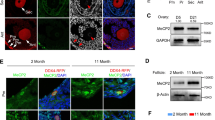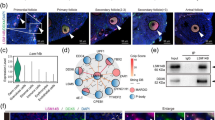Abstract
In mammalian ovaries, many studies demonstrated that the proliferation and apoptosis of granulosa cells are involved in folliculogenesis. Previous evidence suggests that miR-126-3p might get involved in the proliferation and apoptosis of granulosa cells, and tuberous sclerosis complex 1 (TSC1) gene was predicted as one target of miR-126-3p, and moreover, granulosa cell-specific TSC1 knockout stimulated folliculogenesis in mice. However, the molecular regulation of miR-126-3p on TSC1 and its effects on cell proliferation and apoptosis remain virtually unexplored in granulosa cells. Using porcine granulosa cells as a model, the luciferase report assay, mutation, deletion, Annexin-V/PI staining, and EdU assays were applied to investigate the molecular mechanism for miR-126-3p regulating the expression of TSC1 and their effects on the cell proliferation and apoptosis. We found that miR-126-3p showed a positive effect on cell proliferation and a negative effect on cell apoptosis in porcine granulosa cells, and knockdown of TSC1 significantly promoted cell proliferation and significantly inhibited cell apoptosis in porcine granulosa cells. Furthermore, miR-126-3p might target and repress the expressions of TSC1 at the post-transcriptional level, thereby promoting cell proliferation and inhibiting cell apoptosis of granulosa cells. These findings would provide of great insight in further exploring the molecular regulation of miR-126-3p and TSC1 on the functions of granulosa cells during the folliculogenesis in mammals.




Similar content being viewed by others
References
Adhikari D, Zheng W, Shen Y, Gorre N, Hamalainen T, Cooney AJ, Huhtaniemi I, Lan ZJ, Liu K (2010) Tsc/mTORC1 signaling in oocytes governs the quiescence and activation of primordial follicles. Hum Mol Genet 19(3):397–410
Cho IS, Kim J, Seo HY, Lim DH, Hong JS, Park YH, Park DC, Hong KC, Whang KY, Lee YS (2010) Cloning and characterization of microRNAs from porcine skeletal muscle and adipose tissue. Mol Biol Rep 37(7):3567–3574
Christenson LK (2010) MicroRNA control of ovarian function. Anim Reprod 7(3):129–133
De Neubourg D, Gerris J, Knaapen M, Kockx M (2003) Human granulosa cells after ovulation induction show caspase-independent cell death. Gynecol Obstet Investig 56(2):106–112
Du C, Lv Z, Cao L, Ding C, Gyabaah OA, Xie H, Zhou L, Wu J, Zheng S (2014) MiR-126-3p suppresses tumor metastasis and angiogenesis of hepatocellular carcinoma by targeting LRP6 and PIK3R2. J Transl Med 12:259
Gu Z, Eleswarapu S, Jiang H (2007) Identification and characterization of microRNAs from the bovine adipose tissue and mammary gland. FEBS Lett 581(5):981–988
Hasegawa T, Kamada Y, Hosoya T, Fujita S, Nishiyama Y, Iwata N, Hiramatsu Y, Otsuka F (2017) A regulatory role of androgen in ovarian steroidogenesis by rat granulosa cells. J Steroid Biochem Mol Biol 172:160–165
He D, Zou T, Gai X, Ma J, Li M, Huang Z, Chen D (2017) MicroRNA expression profiles differ between primary myofiber of lean and obese pig breeds. PLoS One 12(7):e0181897
Hsueh AJ, Kawamura K, Cheng Y, Fauser BC (2015) Intraovarian control of early folliculogenesis. Endocr Rev 36(1):1–24
Huang L, Wang ZB, Jiang ZZ, Hu MW, Lin F, Zhang QH, Luo YB, Hou Y, Zhao Y, Fan HY, Schatten H, Sun QY (2013) Specific disruption of Tsc1 in ovarian granulosa cells promotes ovulation and causes progressive accumulation of corpora lutea. PLoS One 8(1):e54052
Huang L, Yin ZJ, Feng YF, Zhang XD, Wu T, Ding YY, Ye PF, Fu K, Zhang MQ (2016) Identification and differential expression of microRNAs in the ovaries of pigs (Sus scrofa) with high and low litter sizes. Anim Genet 47(5):543–551
Hunter MG (2000) Oocyte maturation and ovum quality in pigs. Rev Reprod 5(2):122–130
Kim YJ, Ku SY, Kim YY, Suh CS, Kim SH, Choi YM (2016) MicroRNA profile of granulosa cells after ovarian stimulation differs according to maturity of retrieved oocytes. Geburtshilfe Frauenheilkd 76(6):704–708
Kowalczykiewicz D, Swiercz A, Handschuh L, Lesniak K, Figlerowicz M, Wrzesinski J (2014) Characterization of Sus scrofa small non-coding RNAs present in both female and male gonads. PLoS One 9(11):e113249
Kranc W, Budna J, Kahan R, Chachula A, Bryja A, Ciesiolka S, Borys S, Antosik MP, Bukowska D, Brussow KP, Bruska M, Nowicki M, Zabel M, Kempisty B (2017) Molecular basis of growth, proliferation, and differentiation of mammalian follicular granulosa cells. J Biol Regul Homeost Agents 31(1):1–8
Lagos-Quintana M, Rauhut R, Yalcin A, Meyer J, Lendeckel W, Tuschl T (2002) Identification of tissue-specific microRNAs from mouse. Curr Biol 12(9):735–739
Li D, Xu D, Xu Y, Chen L, Li C, Dai X, Zhang L, Zheng L (2017) MicroRNA-141-3p targets DAPK1 and inhibits apoptosis in rat ovarian granulosa cells. Cell Biochem Funct 35(4):197–201
Li Y, Fang Y, Liu Y, Yang X (2015) MicroRNAs in ovarian function and disorders. J Ovarian Res 8:51
Li Y, Li X, Sun WK, Cheng C, Chen YH, Zeng K, Chen X, Gu Y, Gao R, Liu R, Lv X (2016) Comparison of liver microRNA transcriptomes of Tibetan and Yorkshire pigs by deep sequencing. Gene 577(2):244–250
Liu J, Du X, Zhou J, Pan Z, Liu H, Li Q (2014) MicroRNA-26b functions as a proapoptotic factor in porcine follicular granulosa cells by targeting Sma-and Mad-related protein 4. Biol Reprod 91(6):146
Maalouf SW, Liu WS, Pate JL (2016) MicroRNA in ovarian function. Cell Tissue Res 363(1):7–18
Mao, Z., L. Fan, Q. Yu, S. Luo, X. Wu, J. Tang, G. Kang and L. Tang (2017). "Abnormality of klotho signaling is involved in polycystic ovary syndrome." Reprod Sci: 1933719117715129
Peng JY, An XP, Fang F, Gao KX, Xin HY, Han P, Bao LJ, Ma HD, Cao BY (2016) MicroRNA-10b suppresses goat granulosa cell proliferation by targeting brain-derived neurotropic factor. Domest Anim Endocrinol 54:60–67
Plendl J (2000) Angiogenesis and vascular regression in the ovary. Anat Histol Embryol 29(5):257–266
Regan SL, Knight PG, Yovich JL, Stanger JD, Leung Y, Arfuso F, Dharmarajan A, Almahbobi G (2017) Infertility and ovarian follicle reserve depletion are associated with dysregulation of the FSH and LH receptor density in human antral follicles. Mol Cell Endocrinol 446:40–51
Sharbati S, Friedlander MR, Sharbati J, Hoeke L, Chen W, Keller A, Stahler PF, Rajewsky N, Einspanier R (2010) Deciphering the porcine intestinal microRNA transcriptome. BMC Genomics 11:275
Soede NM, Langendijk P, Kemp B (2011) Reproductive cycles in pigs. Anim Reprod Sci 124(3–4):251–258
Sontakke SD, Mohammed BT, McNeilly AS, Donadeu FX (2014) Characterization of microRNAs differentially expressed during bovine follicle development. Reproduction 148(3):271–283
Tanaka Y, Park JH, Tanwar PS, Kaneko-Tarui T, Mittal S, Lee HJ, Teixeira JM (2012) Deletion of tuberous sclerosis 1 in somatic cells of the murine reproductive tract causes female infertility. Endocrinology 153(1):404–416
Timoneda O, Balcells I, Nunez JI, Egea R, Vera G, Castello A, Tomas A, Sanchez A (2013) miRNA expression profile analysis in kidney of different porcine breeds. PLoS One 8(1):e55402
Tiwari M, Prasad S, Tripathi A, Pandey AN, Ali I, Singh AK, Shrivastav TG, Chaube SK (2015) Apoptosis in mammalian oocytes: a review. Apoptosis 20(8):1019–1025
Vimalraj S, Miranda PJ, Ramyakrishna B, Selvamurugan N (2013) Regulation of breast cancer and bone metastasis by microRNAs. Dis Markers 35(5):369–387
Wang L, Li C, Li R, Deng Y, Tan Y, Tong C, Qi H (2016) MicroRNA-764-3p regulates 17beta-estradiol synthesis of mouse ovarian granulosa cells by targeting steroidogenic factor-1. In Vitro Cell Dev Biol Anim 52(3):365–373
Wang P, Yang D, Zhang H, Wei X, Ma T, Cheng Z, Hong Q, Hu J, Zhuo H, Song Y, Jia C, Jing F, Jin Q, Bai C, Mao H, Zhao J (2015) Early detection of lung cancer in serum by a panel of MicroRNA biomarkers. Clin Lung Cancer 16(4):313–319 e311
Wu J, Zhu H, Song W, Li M, Liu C, Li N, Tang F, Mu H, Liao M, Li X, Guan W, Li X, Hua J (2014) Identification of conservative microRNAs in Saanen dairy goat testis through deep sequencing. Reprod Domest Anim 49(1):32–40
Yamamoto H, Yamashita Y, Saito N, Hayashi A, Hayashi M, Terai Y, Ohmichi M (2017) Lower FOXO3 mRNA expression in granulosa cells is involved in unexplained infertility. J Obstet Gynaecol Res 43(6):1021–1028
Yang Y, Song KL, Chang H, Chen L (2014) Decreased expression of microRNA-126 is associated with poor prognosis in patients with cervical cancer. Diagn Pathol 9:220
Yuan X, Zhou X, He Y, Zhong Y, Zhang A, Zhang Z, Zhang H, Li J (2018) C/EBPbeta promotes STAT3 expression and affects cell apoptosis and proliferation in porcine ovarian granulosa cells. Genes (Basel) 9(6)
Zhou M, Wang Q, Sun J, Li X, Xu L, Yang H, Shi H, Ning S, Chen L, Li Y, He T, Zheng Y (2009) In silico detection and characteristics of novel microRNA genes in the Equus caballus genome using an integrated ab initio and comparative genomic approach. Genomics 94(2):125–131
Funding
This work was supported by the earmarked fund for the China Agriculture Research System (CARS-35), the Basic Work of Science and Technology Project (2014FY120800), and Guangdong Sailing Program (2014YT02H042).
Author information
Authors and Affiliations
Contributions
Conceptualization: Xiaolong Yuan and Jiaqi Li
Investigation: Xi Deng, Xiaofeng Zhou, Ailing Zhang, and Yan Xin
Writing – original draft: Xiaolong Yuan
Writing – review and editing: Zhe Zhang, Hao Zhang, and Jiaqi Li
All authors read and approved the final manuscript.
Corresponding author
Ethics declarations
All experiments in the present study were performed in accordance with the guidelines of the Animal Care and Use Committee of South China Agricultural University Guangzhou, China (approval number: SCAU#2013-10).
Competing interest
The authors declare that they have no competing interests.
Additional information
Editor: Tetsuji Okamoto
Rights and permissions
About this article
Cite this article
Yuan, X., Deng, X., Zhou, X. et al. MiR-126-3p promotes the cell proliferation and inhibits the cell apoptosis by targeting TSC1 in the porcine granulosa cells. In Vitro Cell.Dev.Biol.-Animal 54, 715–724 (2018). https://doi.org/10.1007/s11626-018-0292-0
Received:
Accepted:
Published:
Issue Date:
DOI: https://doi.org/10.1007/s11626-018-0292-0




